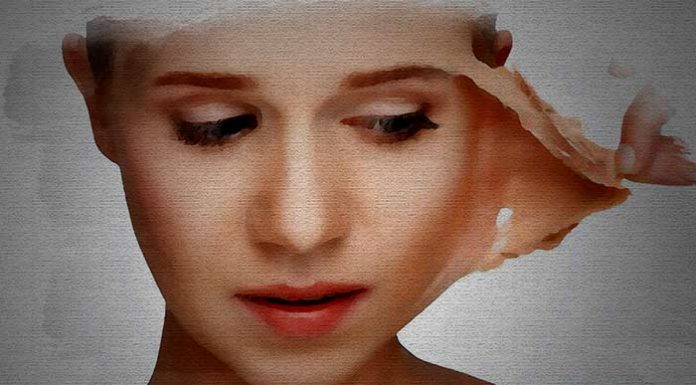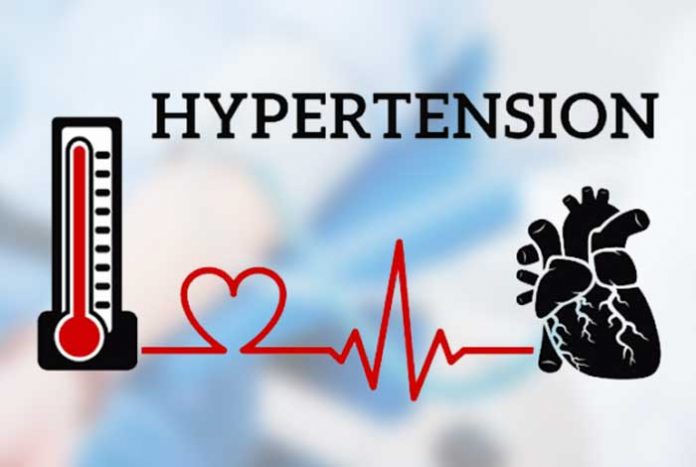
Overview and Facts
Blood is the fluid which is responsible for transporting nutrients and oxygen to the cells and taking away metabolic waste products from them. When this blood flows through the blood vessels- arteries and veins- it exerts pressure on their walls, which is called blood pressure (BP). By default, the pressure in the large arteries of the systemic circulation is taken to determine blood pressure.
Blood is pumped into the arteries when the heart beats. At this point, the pressure is maximum in the arteries and is called systolic blood pressure. When the heart is in resting state, the pressure in the arteries falls, which is called diastolic pressure. Blood pressure is measured in millimeter (mm) of mercury (mm Hg), above the surrounding atmospheric pressure, using an instrument, called sphygmomanometer. Blood pressure is expressed as the ratio of systolic pressure to diastolic pressure. A blood pressure reading between 90/60 mm Hg to 120/80 mm Hg is considered healthy.
When the blood pressure readings are persistently over 140/90 mm Hg, it is called high blood pressure or hypertension. A blood pressure reading between 120/80 mm Hg and 140/90 mm Hg signifies that the person has a potential risk of developing hypertension and should take necessary steps to keep his blood pressure under control.
Hypertension is not a disease in itself but can increase a person’s chance of developing cardiovascular diseases, stroke, kidney disease, vascular dementia and other serious medical conditions.
Across the globe, the prevalence of high blood pressure in adults, belonging to the age group of 25 years and above, has been estimated to be around 40%, highest being observed in the African continent. The proportion of world population having hypertension has risen from 600 million to approximately 1 billion in 2008[Source]. Generally, men are found to be more susceptible to develop hypertension than women. High-income countries are reportedly known to have a relatively low prevalence of high blood pressure incidences. About 9.4 million people die annually and 1.5 billion people suffer from hypertension worldwide. It is known to affect 1 in every 5 persons and is increasingly becoming one of the major causes of death among people belonging to age groups of 55 years and above. People having hypertension are 3 times more likely to develop cardiovascular diseases and stroke and twice more likely to die from these disorders as compared with people having normal blood pressure.

Types and Symptoms of Hypertension
Types of Hypertension
World Health Organization (WHO) and International Society of hypertension (ISH) have laid down certain guidelines for categorizing hypertension. These guidelines are not country specific but are aimed at a global audience and are meant to serve as a template for developing national, regional and local guidelines.
| Blood Pressure (mm Hg) | Grade 1 | Grade 2 | Grade 3 |
| Systolic Blood Pressure | 140-159 | 160-179 | >= 180 |
| Diastolic Blood Pressure | 90-99 | 100-109 | >= 110 |
Table1: WHO/ISH Classification of Hypertension[Source]
In November 2017, American College of Cardiology (ACC) and American Heart Association (AHA) laid down new guidelines for classifying hypertension, especially for the American population. It is the first comprehensive set of guidelines that have been issued since 2003. These new guidelines are expected to classify nearly half of the adult American as being hypertensive. It is expected to hit the younger population more severely than others.
Blood pressure categories according to the new guidelines are:
- Normal: Less than 120/80 mm Hg
- Elevated: Systolic between 120-129 and diastolic less than 80
- Stage 1: Systolic between 130-139 or diastolic between 80-89
- Stage 2: Systolic at least 140 or diastolic at least 90 mm Hg
- Hypertensive crisis: Systolic over 180 and/or diastolic over 120, with patients requiring immediate changes in medication if there are no other indications of problems, or urgent hospitalization if there are suggestions of organ damage.
These guidelines have eliminated the category of ‘Prehypertension’ and have categorized patients into two classes, Elevated (120-129 systolic and less than 80 diastolic), and Stage I hypertension (130-139 systolic and 80-89 diastolic). These guidelines also stress upon the usage of correct technique for measuring blood pressure and recommend the use of validated home-based blood pressure monitoring devices. These guidelines also take into account ‘white coat hypertension’ and highlighted the importance of identifying ‘white coat hypertension’ in patients by healthcare professionals.[Source]
Based on the cause of hypertension it is divided into primary and secondary hypertension.
1. Primary Hypertension: When there is no exact cause for the persistent rise in blood pressure, it is called primary hypertension. It generally develops gradually over time with age.
2. Secondary Hypertension: When there is an increase in blood pressure due to some underlying condition, it is known as secondary hypertension. This type of hypertension appears suddenly and causes a drastic increase in blood pressure than what is observed in primary hypertension.
Some other types of hypertension are:
1. Isolated Systolic Hypertension: Systolic Hypertension is increasingly becoming one of the common health problems among the aging population. Increased stiffness of arteries, especially large arteries results in elevated systolic blood pressure which poses more risk for cardiovascular mobility and mortality than elevated diastolic blood pressure. With age, there is a decrease in elasticity of arteries due to a decrease in elastin fibers and an increase in stiffening fibers, i.e. collagen fibers.
Isolated hypertension can cause a number of serious health conditions like:
- Stroke
- Chronic kidney disease
- Heart failure
- Coronary artery disease
- Aortic aneurysms
Symptoms of isolated systolic hypertension:
- Pain in joints of hands
- Palpitations
- Dry eyes
- Blurring of vision
- Leg cramps
- Nocturia
- Headaches
- Unsteadiness
- Irregular heartbeat

2. Malignant Hypertension: It refers to a condition in which there is a sudden and quick elevation of blood pressure and causes end-organ damage. It is a condition that requires immediate medical attention and is also known as hypertensive emergency or hypertensive urgency.
Symptoms of malignant hypertension are:
- Confusion or mental status changes
- Blurred vision
- Seizures
- Shortness of breath
- Swelling
- Chest pain due to angina, heart attack or aneurysm
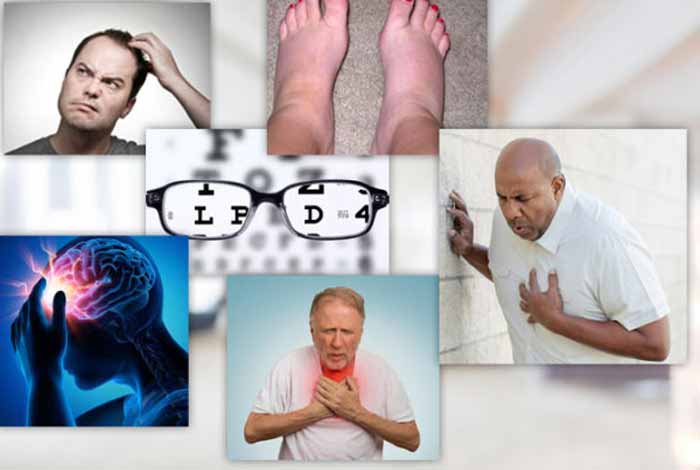
3. Resistant Hypertension: Resistant hypertension as the name suggests is very difficult to control. Blood pressure remains elevated despite the use of 3 anti-hypertensives belonging to different classes, out of which one should be diuretic. Patients who require four or more medicines for controlling their blood pressure are said to have resistant hypertension. These patients are at a higher risk of developing cardiovascular diseases than other people with controlled blood pressure levels.
If a person’s blood pressure can, or cannot be controlled by more than four anti-hypertensive medicines, it is called Refractory hypertension.
Symptoms of resistant hypertension:
- Headache
- Anxiety
- Shortness of breath
- Nosebleeds
- Chest Pain
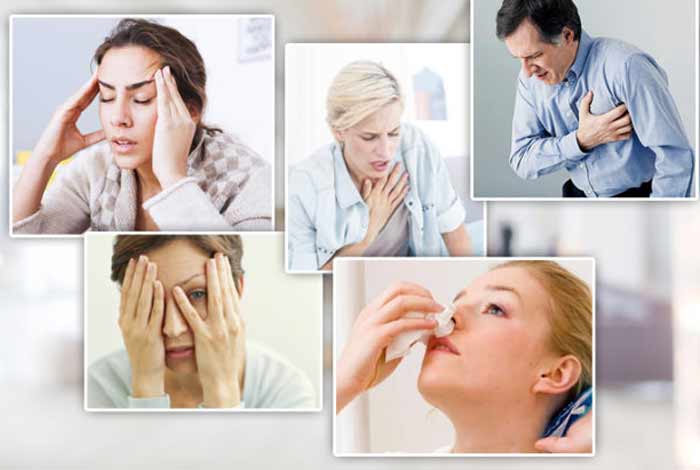
4. Pulmonary Hypertension: It is a type of hypertension which affects the arteries found in lungs and right side of the heart. Pulmonary hypertension can be of several types. In one type of pulmonary hypertension tiny arteries found in the heart, known as pulmonary arterioles, are blocked, narrowed or destroyed. This makes it difficult for the blood to flow through lungs, causing an increase in blood pressure inside the arteries of lungs. As the pressure increases, the heart is made to work harder in order to pump blood through the lungs, which ultimately leads to weakening of heart muscles and heart failure.
Pulmonary hypertension is divided into 6 types, namely:
- Pulmonary arterial hypertension
- Pulmonary hypertension due to left-sided heart disease
- Pulmonary hypertension due to lung disease
- Pulmonary hypertension due to chronic blood clots
- Pulmonary hypertension associated with other conditions that have unclear reasons for pulmonary hypertension
- Eisenmenger syndrome
Symptoms of pulmonary hypertension:
- Shortness of breath (dyspnea), initially while exercising and eventually while at rest
- Fatigue
- Dizziness
- Chest pain
- Swelling (edema) in ankles, legs and eventually in abdomen (ascites)
- Bluish-colored lips and skin (cyanosis)
- Racing pulse or heart palpitation
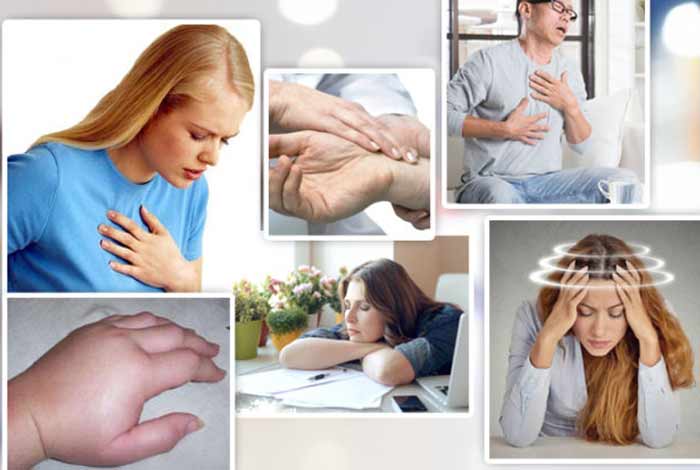
5. Pseudo Hypertension: It refers to a falsely increased blood pressure reading observed in elderly when monitoring blood pressure using sphygmomanometer. However, when blood pressure is measured from within the artery, normal results are obtained. This occurs because there is calcification of blood vessels which decreases its flexibility and gives falsely elevated readings. These people mistakenly get diagnosed as hypertensives even when they are not. However, this condition is known (https://www.who.int/gho/ncd/risk_factors/blood_pressure_prevalence_text/en/ )wn t(https://www.who.int/gho/ncd/risk_factors/blood_pressure_prevalence_text/en/ )o increase a person’s chances of developing cardiovascular disease. This condition is also known as non-compressibility artery syndrome or Osler’s sign of pseudo hypertension.[Source]
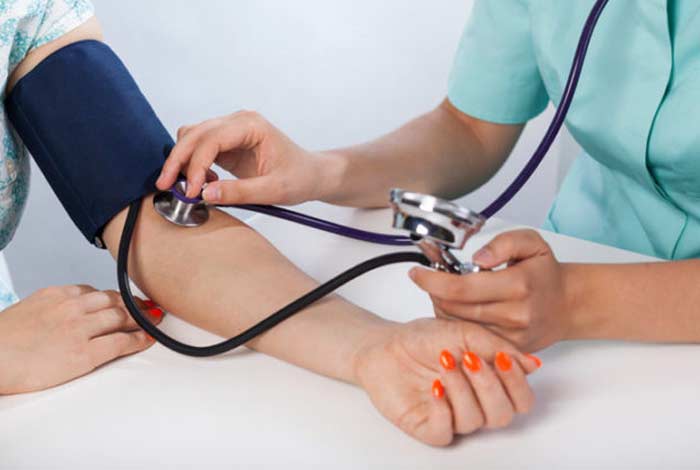
6. White Coat Hypertension (WCH): This is a type of hypertension in which a person shows elevated blood pressure only in clinical setting. Outside the clinic, blood pressure of the person is normal. It is thought that such patients experience extreme stress when in a clinical setup. It is believed that having white coat hypertension increases a person’s chance of having heart disease, stroke, and congestive heart failure.
Symptoms of white coat hypertension:
- Anxiety
- Nervousness
- Sweaty hands
- Shortness of breathing

7. Masked Hypertension: A condition in which normal blood pressure readings are observed inside a clinic and elevated readings outside the clinic. It affects nearly 10% of the people and carries an increased risk of causing organ damage and cardiovascular diseases. It is also observed in treated hypertensive patients and in children, in whom it may be an indication of the development of hypertension later in life.[Source]
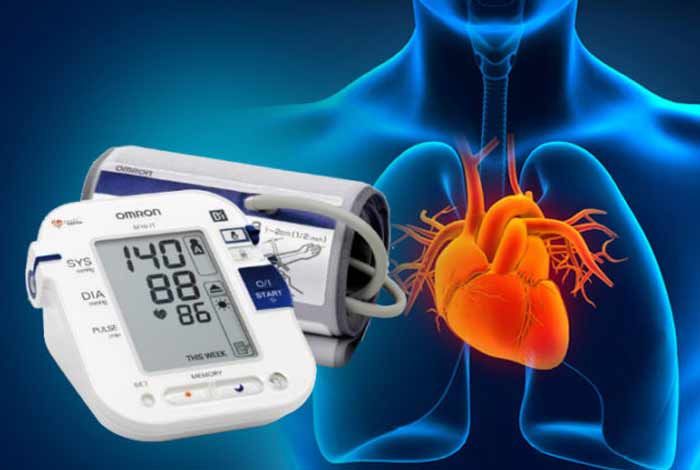
Common Symptoms of Hypertension
Most people with high blood pressure or hypertension do not show any symptoms. This is true even if the blood pressure reaches very high levels to the extent of being dangerous. Few symptoms that are observed by the patient are given below:
- Headaches
- Shortness of breath
- Bleeding nose
- Blood spots in the eye
- Dizziness
- Flushing in the facial region
These symptoms are usually seen in very severe cases. Thus, symptoms might not be observed until the blood pressure reaches a severe or threatening stage.
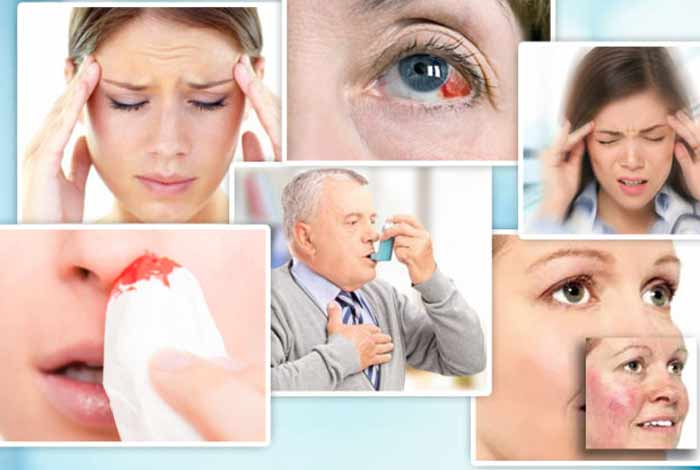
Risk Factors of Hypertension
There are a number of risk factors associated with hypertension. Some of them are as follows:
- Obesity
- Physical inactivity
- Consumption of more than 2 alcoholic drinks per day
- Stress
- Age
- Smoking
- Family history of high blood pressure
- Race (More common in blacks, than whites)
- Use of tobacco
- Too much salt (sodium) in diet
- Too less potassium in diet
- Vitamin D deficiency
- Chronic medical medications like kidney disease, sleep apnea and diabetes
In some cases, hypertension can also be due to pregnancy. It is called Gestational hypertension, which can lead to a serious condition known as preeclampsia in pregnant women.
Although hypertension is generally observed in elderly, children can also develop the condition. This generally happens due to some underlying problems with kidneys or heart. However, unhealthy lifestyle, diet, obesity and physical inactivity is increasing the risk for children to develop this chronic condition.
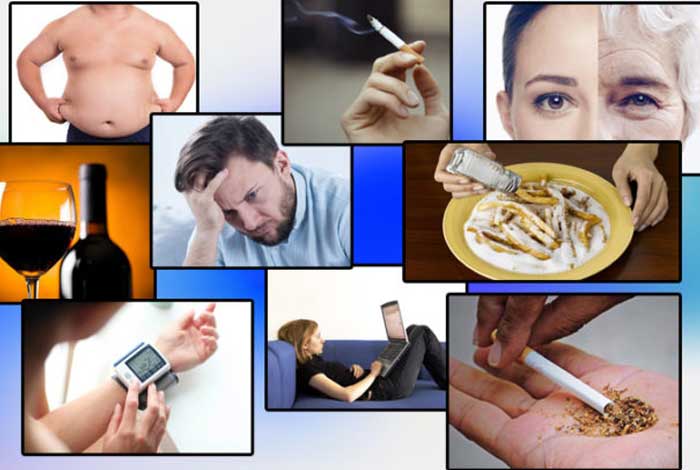
Do I have Hypertension?
Hypertension can only be diagnosed when you measure your blood pressure. Having a single reading of elevated blood pressure does not mean you have hypertension. You must record your blood pressure readings regularly for a minimum of three weeks. If you have a minimum of three blood pressure readings higher than 140/90 mm Hg at least three weeks apart, then there is a chance you might have hypertension. You should also be aware of the white coat masked hypertension. There are be a number of reasons for you to feel the classic symptoms of hypertension like headaches, shortness of breath, nosebleeds, fatigue, and flushing, such as stress, anxiety or panic attack. Visit your doctor and get yourself checked.

Causes and Prevention of Hypertension
1. Causes of Isolated Systolic Hypertension:
- Age
- Drugs like NSAIDs (ibuprofen, naproxen), decongestants (pseudoephedrine), birth control pills, cocaine, antidepressants (fluoxetine, sumatriptan)
- Obesity
- Consumption of foods with high salt content
- Physical inactivity
- Stress
- Diabetes
- Hyperthyroidism

2. Causes of Malignant Hypertension:
Some of the conditions that increase the probability of getting malignant hypertension are as follows:
- Kidney disorders or kidney failure
- Use of drugs like cocaine or birth control pills
- Pregnancy and preeclampsia
- Autoimmune disease
- Spinal cord injuries
- Renal stenosis
- Narrowing of aorta
- Aortic dissection
- Not taking anti-hypertensive drugs
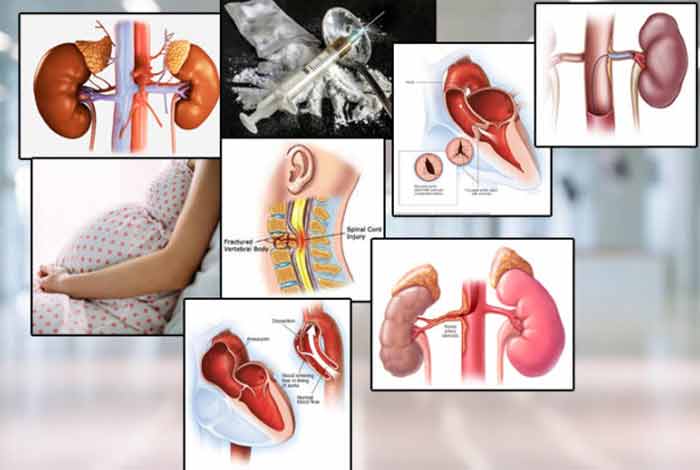
3. Causes of Resistant Hypertension:
Structural Disorders:
- Sleep apnea
- Kidney artery stenosis (narrowing of arteries of kidneys)
- Coarctation of aorta (narrowing of a part of aorta, artery supplying blood from heart to the organs)
- Kidney failure
Hormonal Disorders:
- Primary aldosteronism
- Pheochromocytoma
- Hyperthyroidism
- Cushing’s disease

4. Causes of Pulmonary Hypertension:
a. Pulmonary arterial hypertension
- Unknown cause, leading to primary hypertension
- Genetic
- Drugs like diet drugs, methamphetamines or certain toxins
- Congenital heart disease
- Scleroderma
- Lupus
- HIV infection
- Liver cirrhosis
b. Pulmonary hypertension due to left-sided heart disease
- Left-sided valvular heart disease, like mitral valve or aortic valve disease
- Failure of the lower left heart chamber (left ventricle)
c. Pulmonary hypertension due to lung disease
- Chronic obstructive pulmonary disease, such as emphysema
- Lung disease such as pulmonary fibrosis
- Sleep apnea and other sleep disorders
- Long-term exposure to high altitudes
d. Pulmonary hypertension due to chronic blood clots
- Chronic blood clots in the lungs (pulmonary embolism)
e. Pulmonary hypertension associated with other conditions that have unclear reasons of pulmonary hypertension
- Blood disorders
- Disorders affecting several organs in the body, like sarcoidosis
- Metabolic disorders, like glycogen storage disease
- Tumors pressing against pulmonary arteries
f. Eisenmenger syndrome
- Genes

5. Causes of Pseudo-hypertension:
- Atherosclerosis
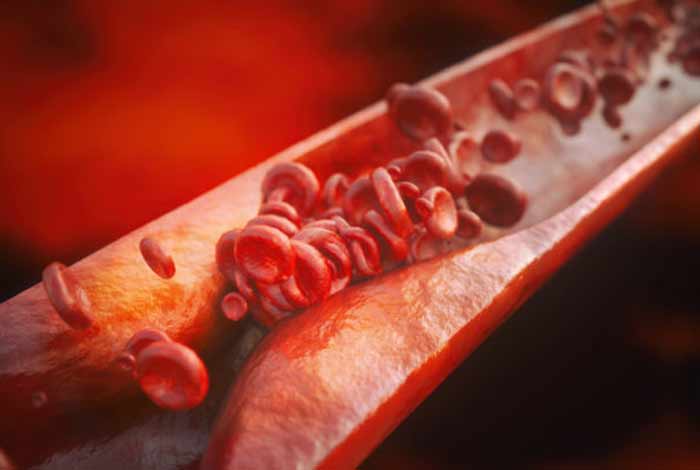
6. Causes of White Coat Hypertension:
- Stress
- Anxiety
- Consuming foods high in sodium
- Consuming high amounts of caffeine

7. Causes of Masked Hypertension:
- Smoking
- Alcohol consumption
- Stress
- Increased physical activity during daytime

Prevention of Hypertension:
A person can keep his blood pressure in a healthy range and lower the risks of stroke and cardiovascular by following a healthy lifestyle, which includes:
- A healthy diet
- Maintaining healthy weight
- Regular exercise
- Cessation of smoking
- Limited consumption of alcohol
If a person is at a high risk of developing hypertension, he should take these steps as well:
- Regular monitoring of blood pressure
- Decreased intake of salt (sodium)
- Increased intake of potassium
- Vitamin D supplements
- Proper rest
- Limited consumption of caffeine

Diagnosis and Tests for Hypertension
Hypertension does not usually present any symptoms and the only way to find out about it is to measure blood pressure. It is recommended that healthy adults above the age of 40 years should get their blood pressure checked at least once in every 5 years. The frequency of checking blood pressure should be higher in people who are at high risk of developing the condition.[Source]
Measuring blood pressure:
- Blood pressure measurement is done by using a pressure cuff (sphygmomanometer).
- During the test, the person is made to hold out one of his arms at the same level as that of his heart and the cuff is wrapped around the upper arm and is inflated manually or electronically.
- The inflated cuff compresses the brachial artery and momentarily stops blood flow.
- The air in the cuff is slowly released and the person performing the measurement senses the vibration in the patient’s arteries by using a stethoscope or monitors the electronic screen.
- The pressure in the cuff is measured at recorded at two points as the blood begins to flow again in the arm. These readings give the blood pressure readings.
The doctor most likely takes 2 to 3 blood pressure readings each at 3 or more separate appointments before diagnosing a person with hypertension. Blood pressure is measured in both arms in order to determine if there is any difference.
It should be noted that having raised blood pressure once does not necessarily indicate that the person has hypertension. Blood pressure is known to fluctuate throughout the day. Even while visiting a general physician for checking blood pressure can cause stress or anxiety, causing the blood pressure to increase.
If the physician observes that the patient has elevated blood pressure, he might suggest him to take some readings with a home blood pressure monitor or make him wear a 24-hour monitor for checking the blood pressure throughout the day. This will determine whether the person has temporarily or consistently elevated blood pressure. This is called 24-hour or ambulatory blood pressure.

Treatment and Care of Hypertension
Anti-hypertensives are a class of drugs used for treating hypertension. The main goal of the treatment is to keep blood pressure in control so that it can prevent the development of serious complications like stroke. The various classes of drugs are discussed below:
1. Diuretics: Also known as water pills, these are the drugs which decrease blood pressure by increasing the excretion of water and salts from the body. These drugs do not decrease blood pressure in people with normal blood pressure. These are of following types:
- Loop Diuretics: These drugs are effective in controlling water retention in the body. Drugs belonging to this class are Furosemide, Torsemide, Ethacrynic acid and Bumetanide. They are generally prescribed in patients who are suffering from kidney or heart failure.
- Thiazide Diuretics: These drugs also increase elimination of water and sodium from the body in the form of urine. By decreasing the concentration of sodium ion in the blood vessels, the stiffness of blood vessels decreases and blood pressure improves. Hydrochlorothiazide, Bendroflumethiazide, Methyclothiazide, indapamide, and chlorthalidone are some of the drugs belonging to this class.
- Potassium Sparing Diuretics: These are the drugs which increase the excretion of water and sodium from the body without incurring a loss of potassium ions. They are generally given along with thiazide diuretics. Drugs belonging to this class are amiloride, triamterene, spironolactone and eplerenone.
2. Calcium Channel Blockers: Also known as calcium channel antagonists, these are the drugs that are used for relaxing and widening blood vessels by acting on the muscle cells of the arterial walls. They are of two types, Dihydropyridines and Non-dihydropyridines. The drugs in these two categories are given below:
A. Dihydropyridines:
- Amlodipine
- Cilnidipine
- Clevidipine
- Felodipine
- Isradipine
- Nimodipine
- Nisoldipine
- Nitrendipine
B. Non- Dihydropyridines
- Diltiazem
- Verapamil
3. ACE Inhibitors: These drugs act on the renin angiotensin aldosterone system (RAAS), which is a hormone system responsible for regulating blood pressure and electrolyte balance. They do not allow the conversion of a hormone responsible for increasing the pressure inside blood vessels, angiotensin I into its active form, angiotensin II. They also decrease the work load of heart, increase urine output and thereby lower B.P. Captopril, Enalapril, Fosinopril, Lisinopril, Moexipril are some of the drugs belonging to this category.
4. Angiotenism II receptor antagonists: These are the drugs that block angiotensin receptors, which cause an increase in blood pressure by narrowing the blood vessels. By blocking these receptors, blood vessels become dilated and therefore, blood pressure reduces. Some of the drugs of this class are Azilsartan, Candesartan, Eprosartan, Losartan, Telmisartan and Valsartan.
5. Adrenergic Receptor Antagonists: These are the drugs that work by blocking the action of a hormone, noradrenaline on the adrenergic receptors, alpha and beta receptors. This blockage relaxes the muscles and helps small blood vessels to remain open. They do not allow the arterial muscles to become tightened and keep them open and relaxed, thereby improving blood flow and lowering blood pressure. Drugs belonging to this class are:
A. Beta Blockers:
- Atenolol
- Carteolol
- Labetalol
- Metoprolol
- Nadolol
- Propranolol
- Timolol
B. Alpha Blockers
- Doxazosin
- Phenoxybenzamine
- Prazosin
- Terazosin
C. Mixed Alpha and Beta Blockers
- Carvedilol
- Labetalol
6. Vasodilators: These act on smooth muscles walls of arteries and relaxing them, allowing easy flow of blood. Sodium nitroprusside and hydralazine are drugs of this class.
7. Renin Inhibitors: These drugs act on the renin-angiotensin system (RAAS) which is a hormone system responsible for regulating blood pressure and electrolyte balance. These drugs bind to the receptor and prevent the binding of renin to another hormone . This helps in decreasing blood pressure. Aliskiren is the drug that works through this mechanism.
8. Centrally acting Alpha-2 Adrenergic Receptor Agonists: These drugs act on the alpha-2 receptors present in the brain, open the peripheral arteries and make blood flow smooth and easy. These drugs are used in combination with diuretics. Clonidine, Guanabenz, Methyldopa, Moxonidine and Guanethidine belong to this class.
9. Endothelin Receptor Blockers: Bosentan is an Endothelin Receptor Blocker and works by blocking the receptors of the hormone, endothelin. It is prescribed to patients who have moderate to severe heart failure.
Care for Hypertension
Following are some of the points that can help hypertensive patients in taking care of themselves:
- Rise slowly to prevent falling and fainting
- Take potassium supplements if using diuretics
- Consume a healthy diet, low in sodium, high in potassium and magnesium
- Exercise regularly
- Have a healthy social life
- Manage stress
- Monitor blood pressure regularly
- Take medicines properly, at the right time, everyday
- Practice yoga, breathing exercises and music therapy
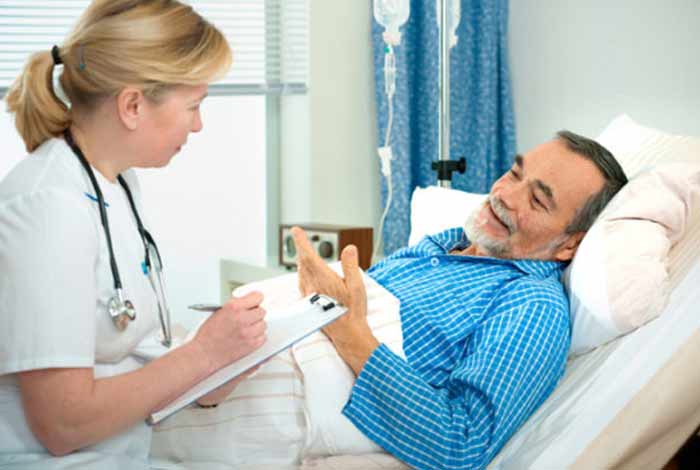
OTC Medications and Self-Management Methods Available for Hypertension
There are no OTC medications available to manage your high BP and it is always recommended to go to physician to know about the proper type and dose of hypertension medication that will be suitable for you. Doctors are extremely concerned about the OTC medicines hypertensives consume as many medicines are known to increase blood pressure. Decongestants like oxymetazoline, phenylephrine and pseudoephedrine, NSAIDs like aspirin and ibuprofen, weight loss medicines and migraine headache medicines are all known to increase blood pressures. However, there are OTC vitamin and mineral supplements that might help in lowering elevated blood pressure. Some of the supplements that can be taken are vitamin C, niacin, fish oil, magnesium and potassium. However, it should be noted that although taking vitamin and mineral supplements seems lucrative, people should always consult with their physicians before taking them.
Self-Management Methods Available for Hypertension:
Hypertension can be easily managed by making some changes in our lifestyle. Some of these changes are:
- Reducing sodium intake to less than 6g a day
- Consuming a low-fat, balanced diet, including plenty of vegetables and fruits
- Regular physical activity
- Reduced intake of alcohol
- Maintaining healthy weight
- Decreased consumption of caffeine
- Cessation of smoking
- Proper rest, sleeping for at least 6 hours a night
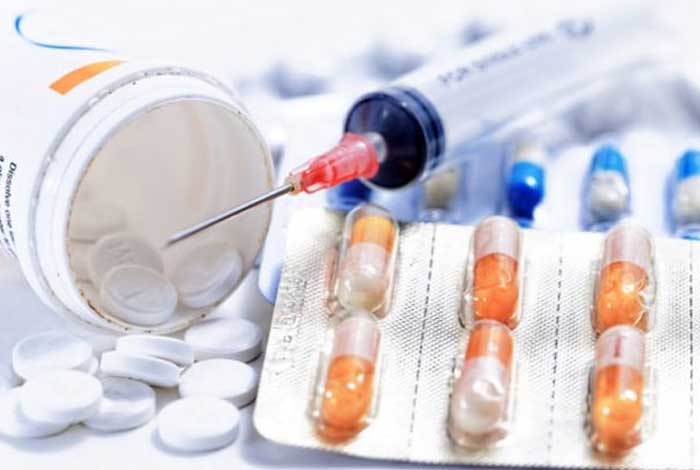
Natural Ways to Cure Hypertension
Some natural ways that can help a person in managing his hypertension are:
- Consumption of Mediterranean diet: Mediterranean diets are rich in fruits, vegetables, sea foods and healthy omega-3 fats. A grain-free or a low-grain Mediterranean diet which is naturally fortified with omega-3 foods, is ideal for preventing cardiovascular diseases and weight reduction. Olive oil, wild-caught fish, especially salmon, flax seeds, and lots of fruits and vegetables, have the potential of lowering blood pressure naturally.
- Fish oil supplement (1,000-2,000 mg daily): A study has shown that consumption of fish oil, which is rich in eicosapentaenoic (EPA) and docosahexaenoic acid (DHA) forms of omega-3 fatty acids, can help in preventing cardiovascular diseases.
- Potassium Supplements: Avocado, banana, coconut water and melon are potassium rich foods that can help in counteracting the role of sodium in hypertension and protect the body against the ill- effects of high blood pressure. Potassium rich foods are more effective in reducing hypertension than potassium supplements. It is advised not to take potassium supplements in high doses unless prescribed by a doctor.
- High fiber foods: Foods that are rich in fiber like fruits, vegetables, and seeds should be consumed in healthy proportions to maintain normal blood pressure.
- Low sodium foods: Excess consumption of sodium in the diet elevates blood pressure. Its consumption should be limited to not more than 1,500–2,000 mg daily.
- Dark chocolate: Consuming dark chocolate containing at least 200 milligrams of cocoa phenols can help in reducing blood pressure.
- Garlic: It is food that can help in lowering blood pressure by relaxing smooth muscles. Garlic also has blood thinning properties and prevents blood vessels from getting blocked and hence, decreases blood pressure.
- Spinach: It is a food that is naturally fortified with magnesium and folate and therefore, can help in preventing hypertension and heart disease.
- Sunflower Seeds: These are rich in magnesium, potassium, and healthy plant fats and are thought to reduce cholesterol levels, dilate blood vessels and promote normal blood pressure.
- Tomatoes: Loaded with potassium, calcium, vitamins A, C, and E and lycopene, tomatoes prevent cholesterol buildup in blood vessels and resist development of hypertension in a number of ways.
- Broccoli: Being a host of beneficial nutrients, it is specifically loaded with potassium and chromium that have a role to play in regulating blood sugar levels and weight, both of which are responsible for causing high blood pressure in their own ways.
- Melon: Cantaloupe and watermelon are especially the rich sources of potassium and help in maintaining healthy blood pressure levels.
- Exercises: Becoming physically active can help in reducing a person’s risk of developing hypertension substantially. Yoga, breathing exercises, aerobics, walking, swimming, running and jogging are some of the ways by which a person can effectively manage his hypertension.

Health Tip by Experts
Hypertension is a chronic condition that can lead to a number of diseases, which can be easily taken care by making dietary and lifestyle changes. Patients are advised to walk and exercise regularly to strengthen their heart and increase its efficiency. Sodium, alcohol, refined carbs, sugar and caffeine are some of the biggest enemies of health and their consumption should be decreased. Potassium rich foods, berries, fish oil, garlic, cocoa and other such foods are a person’s best friends when it comes to promoting good health and decreasing blood pressure. They should be made a part of daily diet plan and consumed daily. A disciplined life can make it possible to lead a healthy, happy and long life.






